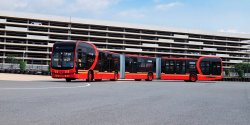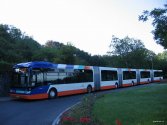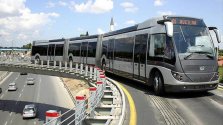Agreed. I actually see this more of a tram replacement/evolution than for bus or train.It's rather complicated to build various quantitative models to determine whether this sort of option is useful for a city. The details matter a lot and without them, one cannot build a decent model which means it's impossible to say how effective this option is. We might feel that subways and buses are sufficient and represent the overall best transport solution but developing a piece of technology isn't necessarily always for immediate profit and application.
For this particular vehicle, it is set apart from trams because it doesn't require the track part. It is NOT a bus. It could be worth developing this so that it might find application when it is thoroughly ready for it. I can actually imagine trackless trams to become the eventual replacement for tracked trams. The city of Sydney Australia recently ripped apart many roads to build tram tracks and it took years to complete. They had trams a century ago and ripped out those tracks to replace with laned roads. Imagine being able to do all those updates and route changes within hours. The only part that isn't yet detailed with this is the energy efficiency.
You are using an out of date browser. It may not display this or other websites correctly.
You should upgrade or use an alternative browser.
You should upgrade or use an alternative browser.
News on China's scientific and technological development.
- Thread starter Quickie
- Start date
Really cool trackless train
This is no different (save for the driverless, autonomous component) from,

and

and many other similar examples.
It's a reskin of an articulated bus.
@Heliox bro, I may disagree, with existing road already established, what you need is a dedicated lane for it to function. Instead of multiple buses clogging the street, this trackless train will carry 3 to 4 times its number reducing traffic. We already try a Bus carousel in EDSA highway (length of EDSA is 24km) and it works, This vehicle is perfect and ideal for us especially with associated cost and time of delivery instead of waiting for a MRT that takes 5 years to build.
I thought the ultimate solution for EDSA is to bomb it all to hell and start from scratch?
In any case I think we are all talking different things here. If you have a dedicated lane for a bus on EDSA (and you can enforce that exclusivity) then it's going to speed up through time down that infernal stretch. You could install a 24km long hop-on-off travellator and it'll still be faster than vehicular traffic on that stretch of hell-on-earth.
As the various post following mine shows, the issue of public transport solutions are complex and that different solutions work for different cities due to varied issues such as pop density, topography, land acquisition, budget, etc, etc.
My original post that was merely in reference to the tweet that the vehicle in question has the qualities of a train without the hassle of a track ... it doesn't. It's a reskinned articulated bus with all the pro/cons of an articulated bus.
The only advantage I understand with this new system, ignoring the potential autonomous aspect, is that it would avoid monopolizing a lane with a dedicated track, like trams do. Otherwise, it works exactly like a bus with the added advantage of increased capacity. So, the main infrastructure required would basically be the right of ways needed, BRT style, along with improvements to road structure, similar to what you use on freeways that use thicker layers of gravel and asphalt. That's all good, but it's still just a bigger bus imo. I see the point of the capacity increase. In that sense, it's not just a BRT improvement, but I still think they shouldn't be calling it a trackless train like it's some new invention.For this particular vehicle, it is set apart from trams because it doesn't require the track part. It is NOT a bus. It could be worth developing this so that it might find application when it is thoroughly ready for it. I can actually imagine trackless trams to become the eventual replacement for tracked trams. The city of Sydney Australia recently ripped apart many roads to build tram tracks and it took years to complete. They had trams a century ago and ripped out those tracks to replace with laned roads. Imagine being able to do all those updates and route changes within hours. The only part that isn't yet detailed with this is the energy efficiency.
I read this article around 5 years ago about a plan for China to eventually develop low-medium speed maglevs as alternatives to more expensive subways.Edit: Also I don't think maglev makes sense for intercity transport. Unless we're talking greater Tokyo sized landmass and placing just a few maglev stations at every major quadrant. Typical subway trains can already reach pretty decent speeds so introducing maglev which offers good speed is senseless for intercity. The thing slowing them down is the distance between stations and you can't have great separation between stops. Maglev infrastructure costs are considerable for what they offer in intercity transport. Maglev as a replacement core tech for HSR, especially between major cities located at considerable distances, that makes sense.
link: China's maglev transit initiative picks up steam
"According to CRMT, future low-speed maglev projects will primarily aim to link large cities with their satellite cities, as well as suburbs to downtown areas. They will also be used in second- and third-tier Chinese cities as a substitute for subways."
This article was from 2016 when the low speed Changsha airport maglev was still being developed. Since then, the low speed maglev train has reduced power requirements while increasing speed from 100km/h to 160km/h (operational speed is capped at 120km/h). A new medium speed maglev train has also been announced that can go 200km/h.
link:
To date, I am aware of 11 municipal or intercity maglev projects going on that are NOT related to their 620km/h high speed maglev project. From all indications, China is going forward with this plan and I would not be surprised that it expands to well over 50 cities in the next 15 years.
From current information, these low-medium speed maglevs China has developed are less expensive than subway systems, can accelerate-decelerate faster and are able to traverse higher incline topography vs tracked transit. In other words, they are a cheaper and better alternative for smaller cities whose economic size do not warrant subway networks. The cost issue shows up more once you start ramping up the speed because the power requirements go up dramatically.
Last edited:
@krautmeister bro the BYD monorail is also an attractive proposition cost wise and easy to construct. An ideal solution for densely populated cities like Metro Manila.The only advantage I understand with this new system, ignoring the potential autonomous aspect, is that it would avoid monopolizing a lane with a dedicated track, like trams do. Otherwise, it works exactly like a bus with the added advantage of increased capacity. So, the main infrastructure required would basically be the right of ways needed, BRT style, along with improvements to road structure, similar to what you use on freeways that use thicker layers of gravel and asphalt. That's all good, but it's still just a bigger bus imo. I see the point of the capacity increase. In that sense, it's not just a BRT improvement, but I still think they shouldn't be calling it a trackless train like it's some new invention.
I read this article around 5 years ago about a plan for China to eventually develop low-medium speed maglevs as alternatives to more expensive subways.
link: China's maglev transit initiative picks up steam
"According to CRMT, future low-speed maglev projects will primarily aim to link large cities with their satellite cities, as well as suburbs to downtown areas. They will also be used in second- and third-tier Chinese cities as a substitute for subways."
This article was from 2016 when the low speed Changsha airport maglev was still being developed. Since then, the low speed maglev train has reduced power requirements while increasing speed from 100km/h to 160km/h (operational speed is capped at 120km/h). A new medium speed maglev train has also been announced that can go 200km/h.
link:
To date, I am aware of 11 municipal or intercity maglev projects going on that are NOT related to their 620km/h high speed maglev project. From all indications, China is going forward with this plan and I would not be surprised that it expands to well over 50 cities in the next 15 years.
From current information, these low-medium speed maglevs China has developed are less expensive than subway systems, can accelerate-decelerate faster and are able to traverse higher incline topography vs tracked transit. In other words, they are a cheaper and better alternative for smaller cities whose economic size do not warrant subway networks. The cost issue shows up more once you start ramping up the speed because the power requirements go up dramatically.
Turkey has metrobuses which are basically huge buses. They were useful so far in Turkey. They are worse than metros for sure but they are better than normal buses.Inst this the same as long busses?
I fail to see the utility of this vehicle. If you want train then you must have huge carrying capacity. I doubt that long trains can get on the road

To think that 10 years ago MagLev was seen as a wunder technology with over expensive investment.The only advantage I understand with this new system, ignoring the potential autonomous aspect, is that it would avoid monopolizing a lane with a dedicated track, like trams do. Otherwise, it works exactly like a bus with the added advantage of increased capacity. So, the main infrastructure required would basically be the right of ways needed, BRT style, along with improvements to road structure, similar to what you use on freeways that use thicker layers of gravel and asphalt. That's all good, but it's still just a bigger bus imo. I see the point of the capacity increase. In that sense, it's not just a BRT improvement, but I still think they shouldn't be calling it a trackless train like it's some new invention.
I read this article around 5 years ago about a plan for China to eventually develop low-medium speed maglevs as alternatives to more expensive subways.
link: China's maglev transit initiative picks up steam
"According to CRMT, future low-speed maglev projects will primarily aim to link large cities with their satellite cities, as well as suburbs to downtown areas. They will also be used in second- and third-tier Chinese cities as a substitute for subways."
This article was from 2016 when the low speed Changsha airport maglev was still being developed. Since then, the low speed maglev train has reduced power requirements while increasing speed from 100km/h to 160km/h (operational speed is capped at 120km/h). A new medium speed maglev train has also been announced that can go 200km/h.
link:
To date, I am aware of 11 municipal or intercity maglev projects going on that are NOT related to their 620km/h high speed maglev project. From all indications, China is going forward with this plan and I would not be surprised that it expands to well over 50 cities in the next 15 years.
From current information, these low-medium speed maglevs China has developed are less expensive than subway systems, can accelerate-decelerate faster and are able to traverse higher incline topography vs tracked transit. In other words, they are a cheaper and better alternative for smaller cities whose economic size do not warrant subway networks. The cost issue shows up more once you start ramping up the speed because the power requirements go up dramatically.
Also tinfoil hat mode on : Strong investment and technological development of MagLev allows PLA Navy to develop EMALS in short time.
This is no different (save for the driverless, autonomous component) from,
View attachment 72303
and
View attachment 72304
and many other similar examples.
It's a reskin of an articulated bus.
The trackless train has significant advantages in terms of safety and comfort over articulated buses of similar capacity.
Articulated buses with more than 2 segments are difficult to drive due to the driver only directly steering and controlling the front segment. The wrong sequence of steering inputs at even moderate speeds can cause the back segments to whip around and back and forth, which is very dangerous on crowded roads. London got rid of all of their articulated buses (which had only two-segments) after finding them many times more likely to be involved in deadly accidents than regular buses. This is why you mostly see articulated buses with more than 2 segments on roads with minimal other traffic.
Articulated buses are also generally less comfortable than even regular buses, let alone trams and light rail. You have the side to side swaying due to over/under steer as well as up and down bobbing at the articulation points due to later segments each having only one pair of wheels (or multiple pairs of wheels that are placed close together).
The trackless train has multiple pairs of steerable wheels on each segment, where the steering is controlled by computers to prevent over/under steer, greatly improving safety as well as maneuverability. The large number of wheels also make the ride much smoother, potentially even better than trams and light rail as the wheels are air filled rubber instead of hard metal.
Last edited:
To me this sounds more like an improved(evolutionary) articulated bus than a trackless trainThe trackless train has multiple pairs of steerable wheels on each segment, where the steering is controlled by computers to prevent over/under steer, greatly improving safety as well as maneuverability. The large number of wheels also make the ride much smoother, potentially even better than trams and light rail as the wheels are air filled rubber instead of hard metal.
I would even say that this is more of an improved tram than anything else.
AssassinsMace
Lieutenant General
Trackless trains been around for three years in China. I believe they actually follow a virtual track and not just someone behind a steering wheel driving it.
Last edited:
@AssassinsMace Sir, Picture yourself riding one here in Manila especially in EDSA, a dedicated lane for this impressive machine hauling in 180 passenger per unit. A very short time to construct (need to build loading and unloading terminals) with minimal expenses. No right of way issue using existing roads and if electrify helps the environment especially with ordinary buses who are diesel powered clogging the lane causing traffic and pollution. For traversing the whole 24 kilometers length of EDSA highway should takes 1 hours from end to end in a normal no traffic scenario, but in reality stuck in traffic it takes nearly 12 hours (causing huge expense in fuel, productivity cost, valuable personal time and mental stress) . When travelling abroad I have to leave my house in Manila 6 hours before my schedule flight if not will never arrive in time. This is the answer for our horrendous traffic problem, with a dedicated lane and designated loading and unloading stops it will displaced a lot of unruly polluting buses therefore easing traffic. A win win solution.Trackless trains been around for three years in China. I believe they actually follow a virtual track and not just someone behind a steering wheel driving it.
